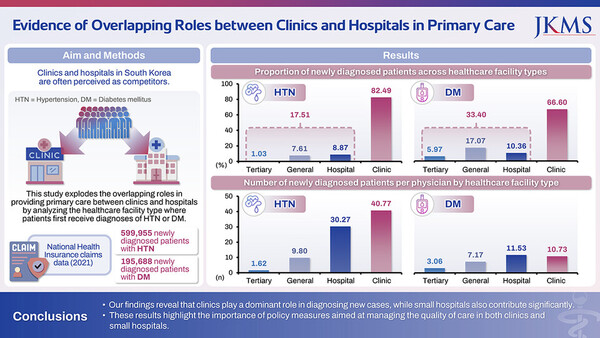The overlapping roles of neighborhood clinics and small- and medium-sized hospitals (SMHs) have been confirmed by statistics.
A significant number of patients with chronic diseases, including hypertension and diabetes, were initially diagnosed at SMHs. The finding highlights the need to incorporate this information into policies aimed at strengthening the primary healthcare system, according to a study.
The Health Insurance Review and Assessment Service (HIRA)'s in-house research institute and the University of Ulsan College of Medicine’s Department of Preventive Medicine analyzed data from 2021 health insurance claims for 599,955 new patients with hypertension and 195,668 new patients with diabetes.
They published their findings in the Journal of Korean Medical Science (JKMS), an international academic journal.

The study found that 82.5 percent (494,911) of patients with hypertension were first diagnosed at clinics, while 17.5 percent (105,044) were first diagnosed at hospitals or higher-level medical institutions. For diabetes, 66.6 percent (133,111) were diagnosed for the first time at outpatient clinics, and 33.4 percent (65,357) were diagnosed at hospitals or higher-level medical institutions.
Based on the statistics of internal and family medicine specialists, there was no difference between clinics and SMHs (with 30–100 beds). The average number of new hypertension patients diagnosed per internist or family medicine specialist was 40.8 at clinics, 30.3 at SMHs, 9.8 at general hospitals, and 1.6 at tertiary general hospitals.
The number of new diabetes patients per internist or family medicine specialist was higher in SMHs. Small- and medium-sized hospitals diagnosed 11.5 diabetes patients per internist or family medicine specialist, while clinics diagnosed 10.7.
The core indicator of primary care quality, continuity of care (COC), was higher in clinics. For hypertension patients, the COC index of 0.75 or higher was highest in clinics at 78.6 percent, followed by general hospitals at 70.3 percent, SMHs at 68.4 percent, and tertiary general hospitals at 62.9 percent.
A COC index of 0.75 or higher indicates high continuity of care. Diabetes patients also showed high continuity of care when first diagnosed at clinics, followed by tertiary general hospitals, general hospitals, and SMHs.
“This study confirmed that clinics and small- and medium-sized hospitals play an important role in providing primary care, and that government policies should reflect this situation,” the researchers said. “It is necessary to strengthen the clinic-centered primary care system while systematically managing the quality of primary care provided by small- and medium-sized hospitals.”

